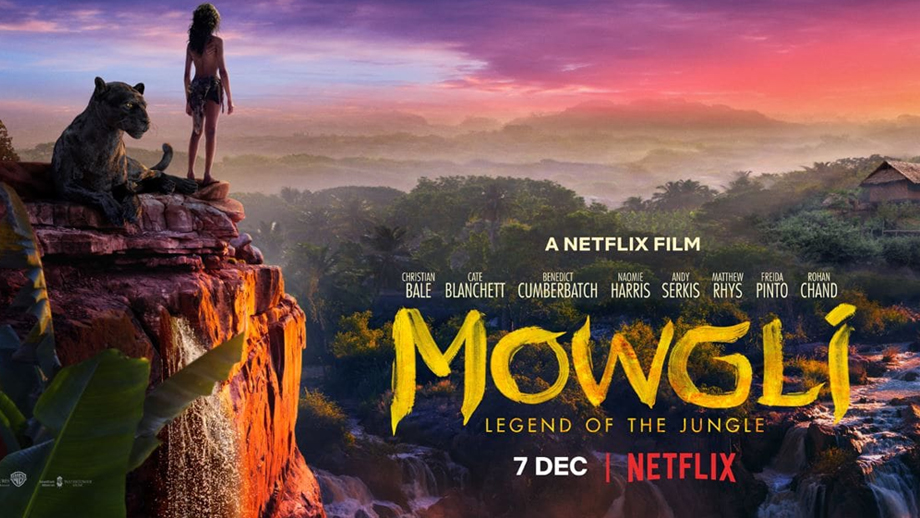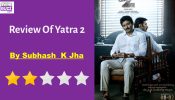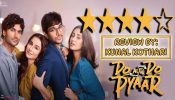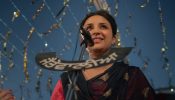“Hunting is sacred, Little Brother. It is our right. But we never do it for sport,” says Bagheera the Black Panther, as he enlightens Mowgli on the primeval laws of the jungle.
These words, uttered within the first ten minutes of the Netflix stunner, Mowgli – Legend of the Jungle, set the tone for the vortex of emotions and passions that sweep us in its current, in this bewitching retelling of Rudyard Kipling’s masterpiece, ‘The Jungle Stories’.
The Jungle Stories, that timeless tale of a man-cub brought up by wild animals in a yawning Indian jungle, continues to hold us in its thrall, more than a hundred years after it was first written. This rapturous fascination with the moving chronicle has resulted in two previous mega-flicks, both by Disney Studios, and numerous adaptations based on its narrative, around the world. Mowgli is the latest adaptation of Kipling’s work to hit our screens.
The basic premise of the movie is the same as the previous versions. The story begins with Kaa the python (Cate Blanchett) narrating the carnage let loose in the jungles of India by Shere Khan (Benedict Cumberbatch), the tiger-turned-man eater. Shere Khan kills and eats a human couple, against the laws of the jungle. Bagheera (Christian Bale), a black panther, finds their baby, covered in its parents’ blood. The child is at grave risk of falling prey to Shere Khan, who considers him part of his kill. Bagheera takes the child to a pack of wolves, residing within the jungle, for safekeeping.
Led by leader of the pack, Akela (Peter Mullan), wolf parents, Nisha and Vihaan (Naomie Harris and Eddie Marsan), Bagheera and Baloo the Bear (Andy Serkis), the animal pack adopts the child to raise it as one of its own, when it realizes that Shere Khan, along with his trusted hyena follower, Tabaqui (Tom Hollander), is on the baby’s trail.
The face-off between Shere Khan and the wolf pack, as it rallies around the man-cub, is riveting, to say the least. Ultimately, Shere Khan is forced to retreat. The child is named Mowgli. Bagheera takes Mowgli under his wings, while Baloo is tasked with teaching Mowgli the tricks of the trade of being a wolf.
Years pass and Mowgli grows up to become a strong and striking young boy-wolf. Rohan Chand plays the young Mowgli. He runs on all fours, eats his meat raw like his wolf brethren and undergoes furious training to become a part of the hunting pack. But as Mowgli grows, it becomes painfully apparent to him that he is somehow different from his wolf brothers. His distinctiveness rankles immeasurably, even as he tries harder to fit in with the pack. Bhoot (Louis Ashbourne Serkis), an albino wolf cub, is his closest friend, as each draws comfort from the other in their mutual otherness. Finally, as Shere Khan returns to stake his claim to the boy, Mowgli is banished to the man-village for his own safety, a decision he doesn’t take too kindly to.
Once among humans, Mowgli takes a liking to Messua (Freida Pinto), the village woman who cares for him, and to John Lockwood (Matthew Rhys), a colonial hunter, who teaches Mowgli how to use a hunting knife. Facing an acute existential dilemma, Mowgli is torn between his innate humanness and his adoptive wolf identity. It takes a truly horrifying discovery near the end, for Mowgli to realize that the hunter is the actual villain of the piece. The climax, when it comes, is rabid, violent and intensely fascinating. It is also unlike anything we’ve seen in any of the previous Jungle Book versions. The movie ends on an uplifting note, as it rests its hopes on the inherent power of man to broker peace – the need of the hour today – if he wants it badly enough, that is. The story is where Mowgli’s similarity with the other adaptations ends, and the dissimilarity begins.
For, this version of The Jungle Book is nothing like its predecessors. While the previous versions were all treacly sweet and syrupy, Mowgli is grit, guts and gore. It is angsty, ardent and impassioned; it is crammed with feeling, heavy with evocative innuendos. It slams home with deafening impact the fact, that mankind is the worst species to have ever walked on Earth and that no other earthly species is as dangerous as man. We kill for sport, we plunder for greed and we destroy for selfish gain – something that beasts, be they of any hue or kind, never ever do. No wonder Mowgli rejects his human heredities and chooses to be a wolf over being a man. Directed by the maven of mo-cap and The Lord of the Rings and Planet of the Apes motion-capture legend, Andy Serkis, Mowgli scores on several counts where its predecessors simply failed to make their mark. While the previous versions were undoubtedly a great watch, they were like a beautiful bauble kept in a show window, one that you admire and then forget about.

Serkis’s Mowgli, on the other hand, stays with you, and lingers in your mind’s eye, days after you’ve finished watching it. Mowgli makes you feel, think, ponder – on the ravages unleashed by man on nature; on the man-animal conflict and how humans are increasingly encroaching upon forest land; on the way we humans treat other humans who are even remotely different – a point driven home poignantly by the way both Mowgli and Bhoot are called freaks by the other young wolves in the pack. The scene, where Mowgli blasts Bhoot for sugar-coating their divergence as being special, telling him that he’s not special, he just came out wrong, was gut-wrenching.
Neel Sethi, in Favreau’s 2016 version, looked like a kid out on a day picnic on the fringes of the forest neighbouring his home, ambling along, taking in the sights and sounds of the sun-dappled greenery around him, making the acquaintance of the overly-friendly bear he comes across on his jungle jaunt.
Not so with Mowgli.
Serkis’ Mowgli has a powerful, raw earthiness about him. He looks like a creature borne from the bowels of the deep, dark Indian jungle, just like every other creature that dwells in that wild, mystical world. He blends into the dark, dreary surroundings just like creatures of the jungle are meant to. He is combative, feral and fearless. Rohan Chand is beyond marvellous as Mowgli.
Likewise, the first time that Shere Khan comes face to face with Mowgli in Disney’s Jungle Book lacks the terrifyingly menacing quality that suffuses the frame when Shere Khan first sets eyes on the grown-up Mowgli in Serkis’ narrative. As the two size each other up – Mowgli, from within the depths of the water that is speckled with red by Shere Khan lapping up the water with his mouth bloodied from his latest kill, and then he stops drinking and stares down at into the water at Mowgli with an ominous grin….. the pure evil that emanates from Shere Khan in that scene chilled us to the bone.
Phew, in a moment of quietude, that scene will sneak up on you when you least expect it to, catching you unawares, and giving you that unfamiliar unsettling feeling in the pit of your stomach. Yup, believe us ye, it’s a scene that brims with sheer malevolence.
The elephants in Mowgli are a sight to behold. Hathi, the leader of the pack, is impressive, imposing and monolith-esque, all the more apparent by his moss-covered hide. He appears like an ancient sentinel of jungle mores. The ambush at the end, featuring the elephants, is stunning. So is Mowgli, when he screams, “Khaaaan”, his voice reverberating through the jungle, as he throws down the gauntlet before Shere Khan, conveying, in no uncertain terms, that he means business.
Bagheera and Baloo too are a departure from their gentle, genial avatars in the earlier Jungle Book adaptations. Here, the two are more like battle-scarred warriors – imperiously stern and unwilling to give an inch.
Kaa is mesmerizing and enigmatic. The voice acting is brilliant and emotive, adding untold depth to the narrative. Cumberbatch, Christian Bale, Cate Blanchett and Serkis have nailed it spectacularly. The other voice actors are superb too.
The Hindi version of Mowgli has the added Bollywood attraction with popular actors lending their voices to characters in the film. Jackie Shroff voices for the majestic Shere Khan, while Abhishek Bachchan gives voice for the tactful Bagheera. Baloo is voiced by Anil Kapoor, and Kareena Kapoor gives voice to Kaa, and Madhuri Dixit Nene to Nisha.
While the mo-cap has been roundly criticized, we felt that the human features and expressions on the animals added an intense edge to their characterizations, making them impactful, memorable and extraordinarily real.
Serkis’ direction is impressive; the music by Nitin Sawhney is haunting and adds a hint of whimsy to the narrative; and lastly, Callie Kloves’ screenplay is first-rate. Mowgli – Legend of the Jungle is definitely worth a watch, or several, in our opinion. The cast and crew have poured their heart into its making, and it shows. It can rightly be called Serkis’ labour of love, for it truly is that. The movie exudes magnificence in its stunning visuals and imagery.
Tis a pity Mowgli did not get a worldwide theatrical release. It deserves a larger canvas to showcase its brilliance. Its only shortcoming is that it was too long in the making, the primary reason why it was beaten to the theatres by Disney’s 2016 version. And also the reason why producers Warner Bros sold the distribution rights to Netflix. Had it released first in the theatres, it would have been a resounding success.
IWMBuzz gives Mowgli – Legend of the Jungle a 4/5.
(Written by Rashmi Paharia)











